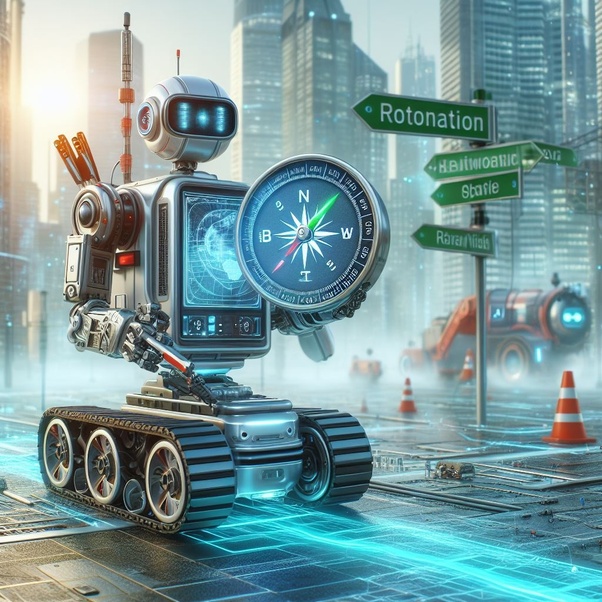In the ever-evolving landscape of robotics, one of the most captivating advancements is the emergence of autonomous mobile robots (AMRs). These intelligent machines are revolutionizing industries by offering efficient, reliable, and versatile solutions for various tasks, from warehouse logistics to healthcare assistance. At the heart of their functionality lie sophisticated navigation systems, with Global Positioning System (GPS) and compass technology playing pivotal roles. This article delves into the workings of these navigation systems within AMRs and explores their significance in shaping the future of automation.
Understanding Autonomous Mobile Robots: Autonomous mobile robots are self-directed machines designed to perform tasks without continuous human intervention. They navigate through their environment, make decisions, and execute actions based on programmed algorithms and sensor feedback. Unlike their traditional robotic counterparts, which often rely on fixed paths or manual guidance, AMRs possess the autonomy to adapt to dynamic surroundings, enhancing their versatility across various applications.
The Role of GPS in Autonomous Navigation: GPS, a constellation of satellites orbiting the Earth, provides precise positioning and timing information to users worldwide. In the realm of AMRs, GPS serves as a fundamental component of their navigation systems, enabling them to determine their exact location relative to predefined waypoints or maps. By receiving signals from multiple satellites, these robots can triangulate their position with remarkable accuracy, facilitating efficient movement within large-scale environments such as warehouses, outdoor facilities, and agricultural fields.
However, while GPS offers unparalleled global coverage and accuracy under open-sky conditions, it poses challenges in environments where satellite signals may be obstructed or distorted. Indoors, dense structures, metallic surfaces, and electromagnetic interference can degrade GPS accuracy, rendering it unreliable for precise navigation. To mitigate these limitations, AMRs integrate complementary navigation technologies, including inertial measurement units (IMUs), wheel encoders, and, notably, compass systems.
The Significance of Compass Technology: Compass technology, specifically magnetometers, complements GPS by providing reliable orientation data regardless of GPS signal availability. By detecting the Earth's magnetic field, magnetometers allow AMRs to ascertain their heading with respect to cardinal directions, thereby enhancing their navigation capabilities in environments where GPS alone may falter. This is particularly crucial in indoor settings, where GPS signals are often attenuated or nonexistent.
Unlike GPS, which primarily focuses on position fixing, compass technology emphasizes directional awareness, enabling AMRs to maintain accurate heading information as they traverse complex environments. By combining GPS-derived position data with compass-derived orientation data, these robots can effectively navigate through intricate pathways, corridors, and indoor spaces with confidence and precision.
Moreover, compass technology offers inherent robustness against signal interference and environmental factors that commonly affect GPS performance. By leveraging magnetic sensors and advanced algorithms, AMRs can filter out noise and disturbances, ensuring consistent and reliable orientation readings even in challenging conditions. This resilience is essential for mission-critical applications where navigation errors could lead to costly delays or safety hazards.
Integration and Fusion of Navigation Systems: In practice, autonomous mobile robots harness a fusion of navigation systems to achieve seamless and robust localization and navigation capabilities. Through sensor fusion techniques, such as Kalman filtering and Bayesian inference, these robots integrate data from GPS receivers, compass modules, IMUs, wheel encoders, and environmental sensors to generate a comprehensive understanding of their surroundings.
The fusion of GPS and compass technology exemplifies the synergy between absolute positioning and relative orientation, enabling AMRs to navigate effectively across diverse operating environments. By continuously updating their position and orientation estimates based on sensor feedback, these robots can adapt to changing conditions, correct for drift, and maintain accurate localization throughout their missions.
Applications and Implications: The integration of GPS and compass technology unlocks a myriad of applications for autonomous mobile robots across various industries:
- Warehouse Automation: AMRs equipped with GPS and compass navigation excel in warehouse environments, efficiently transporting goods between shelves, optimizing inventory management, and navigating around obstacles with precision.
- Agriculture and Field Robotics: In agricultural settings, AMRs utilize GPS and compass technology to perform tasks such as crop monitoring, soil sampling, and precision spraying, improving farm productivity and sustainability.
- Healthcare Assistance: In healthcare facilities, AMRs equipped with navigation systems assist with patient care, medication delivery, and logistics, enhancing operational efficiency and patient outcomes.
- Infrastructure Inspection: AMRs equipped with GPS and compass navigation systems are employed for infrastructure inspection tasks, including pipeline monitoring, bridge inspection, and facility maintenance, reducing risks and operational costs.
Conclusion: Autonomous mobile robots represent a paradigm shift in automation, offering unprecedented flexibility, efficiency, and adaptability across diverse applications. Central to their functionality are advanced navigation systems, with GPS and compass technology playing pivotal roles in enabling precise positioning and orientation awareness. By integrating these technologies and leveraging sensor fusion techniques, AMRs can navigate effectively in dynamic environments, unlocking a multitude of opportunities for innovation and optimization. As we continue to push the boundaries of robotics, the synergy between GPS and compass technology will remain instrumental in shaping the future of autonomous mobility and redefining the possibilities of automation.
#AutonomousRobots #NavigationTechnology #GPS #Compass #RoboticsInnovation #Automation #FutureTech #SensorFusion #Industry40 #WarehouseAutomation #PrecisionNavigation #RoboticsApplications #AI #EmergingTech #InnovationInAutomation#AutonomousMobileRobots #GPSNavigation #CompassTechnology #RoboticsRevolution #SmartTechnology #TechAdvancement #NavigationSystems #IndustrialAutomation #PrecisionRobotics #InnovationInRobotics #RoboticsTechnology #DigitalTransformation #TechTrends #NavigationSolutions #RoboticsIndustry #amoltechnicalguru #7447253589

